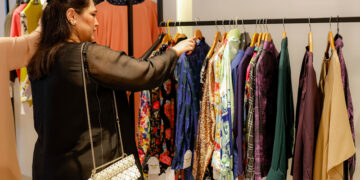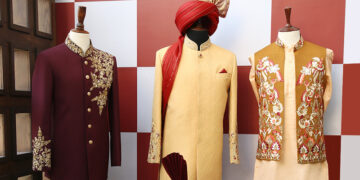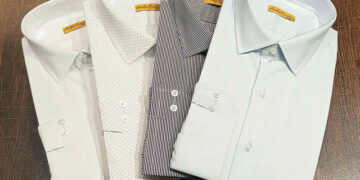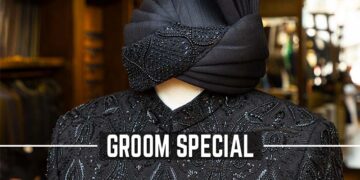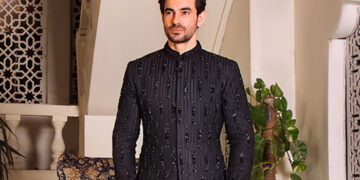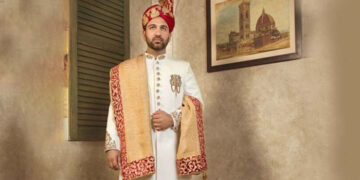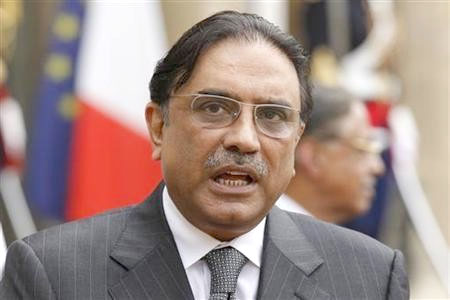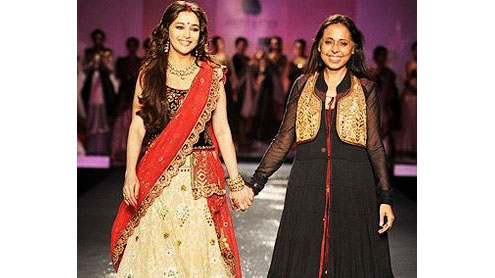
Inspired by some of the prominent women characters from Bengali literature, the designer through her garments wished to delve into the nuances of womanhood in terms of strength of character, willpower, benevolence and affection.
Anju Modi’s idea of the ‘Devi’ (or Goddess) is not restricted to a woman sketched in strokes of divinity but her significance in life as a strong force whose absence can turn things wrong. Says Anju, “The philosophy of my collection was to acknowledge and pay emphasis to all shades of a woman, to bring out the true meaning of womanhood through powerful colours like reds and charcoal blacks.”
Collection and theme: The serene Ganges, the brilliant architecture of the Victoria Memorial, the streets of colonial Calcutta and the Howrah Bridge constituted the collage of images screened in the background that brought alive the spirit of this cultural state. Models walked the runway dressed in layered outfits that had an array of achkans, lehengas and ghagaras worn below tube or strapless blouses, sarees coupled with dangling tassels from one shoulder or heavy dupattas draped in neat pleats or folds. One-shoulder jackets, bejewelled corsets in nets, shrugs ending in pretty knots from around the waist, translucent dupattas bordered in gold embroidery added a modern twist to traditional crafts of weaving.
Colour palette and design: Apart from the bold reds and the intense blacks, the colour scheme played with shades of brown, white, hint of green and gold. Frilled collar jackets, sometimes, changing into shredded cuts, wrists done up in frills, spiral patterns embossed on the surface of capes and jackets worn over blouses rendered a flavour of vintage dressing to the collection.
The couture became representative of the designs flaunted by women protagonists in Bengali literature later visualised in cinema. “Devi, Sahib Bibi Ghulam, Parineeta, Charulata and Devdas have portrayed women of passion, enigma, integrity and elegance in literature and movies. My collection derives its significance from the same. Madhuri’s poise, integrity and elegance made me pronounce her the ‘Devi’ of my collection,” informs the designer.
Fabrics and craftsmanship: Bengal and brides make for a beautiful association and this union finds an expression in every garment stitched by skilled artisans. Dhakai muslins, cotton, silk and tassar woven in single thread by craftsmen in the villages of Bengal were visible in Anju’s clothing line. Handcraft, Anju feels, “requires meditative effort and personalised detailing to reach a level of perfection in couture.”
Block printing and vegetable dyeing were some of the sartorial techniques apparent in the designs. Embellishments in pearls and tarkashi work sewed by hand enhanced the volume of the beaded bridal trousseau. The Victorian touch to the range was visible as we saw tunics extending to puffed lehengas done up in multiple layers and asymmetric cuts. Heavy gold earrings, enhanced eye makeup, bangles, intricate hair bun clips and models’ foreheads dotted in white bindis accessorised the showcased garments quite well.
Madhuri Dixit, the goddess on ramp: Luscious locks, the vermillion mark glistening on her hair parting and the to-die-for glance that she cast on the spectators had us skip a heartbeat when the Bollywood diva and dancing Queen Madhuri Dixit sashayed down the runway. Looking vivacious in a full embroidered lehenga in cream, black sleeveless blouse and wrapped in a red muslin dupatta, Devdas’ ‘Chandramukhi’ floored the viewers who had by then lost a count of the whistles as the hall echoed in a thunderous applause. The actress read a few lines from one of Tagore’s poems before entering the ramp and the moment she walked in, the popular Rabindra Sangeet ‘Ekla Cholo Re’ (Walk alone) in Amitabh Bachchan’s voice accompanied her every stride in perfect harmony. – TOI



